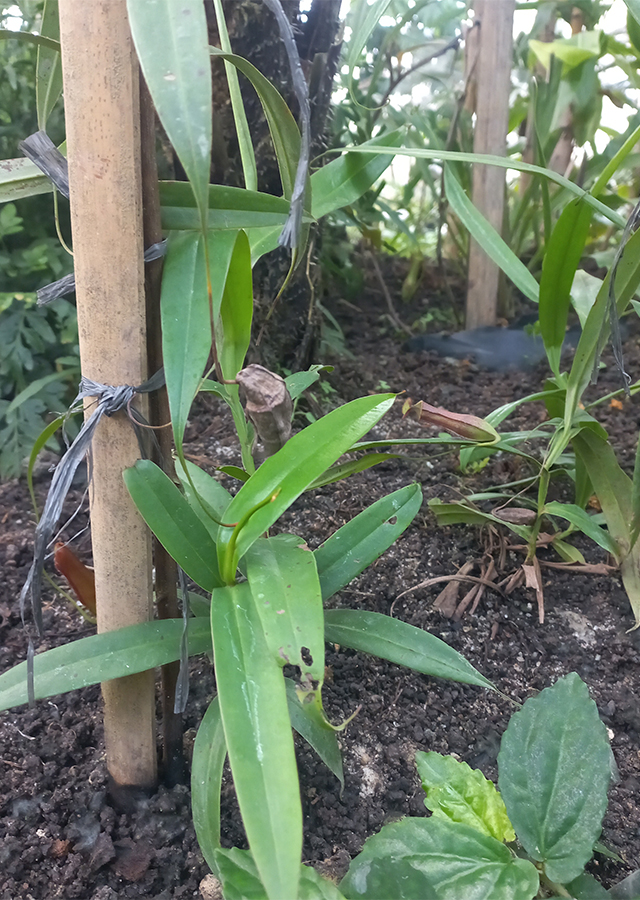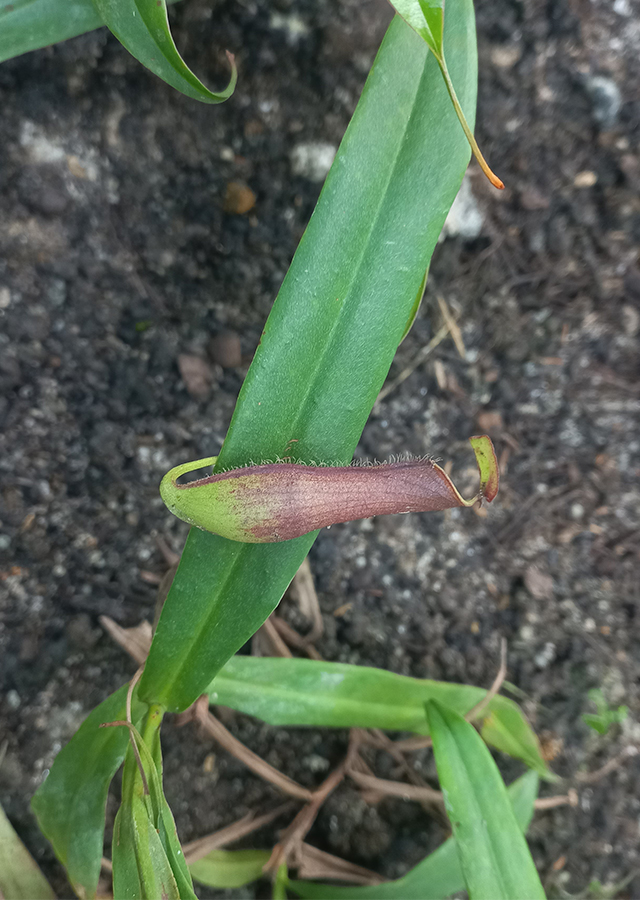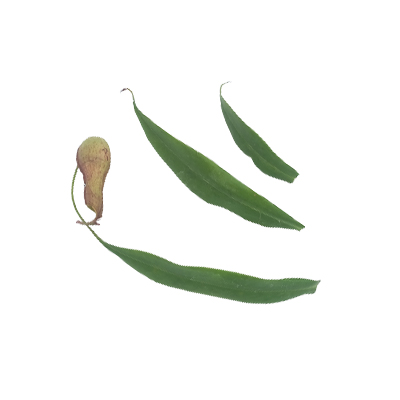Swamp Pitcher-plant
Nepenthes mirabilis (Lour.) Druce
Nepenthaceae
Location in our garden
Green House



Synonym
Nepenthes albolineata F.M.Bailey
Nepenthes alicae F.M.Bailey
Phyllamphora mirabilis Lour.
Habitus
Herbaceous. Climbing herb, height up to 7 m
Part Used
Leaves
Stem
The Whole Plant
Growing Requirements
Need Shade
Habitat
Riverbanks
Forest
Overview
Nepenthes mirabilis is one type of pitcher plant with the widest distribution area when compared to other types of Nepenthaceae. This species is found from Hainan (northern hemisphere) to Cape York (southern hemisphere), from the Mentawai Islands in the west to New Guinea in the east. In Indonesia, this species is found in Bengkulu, Jambi, Lampung, Riau, West Sumatra, South Sumatra and North Sumatra. The trunk of this species is used by local people as a rope fence. The plant also has a unique pouch and became an attraction ornamental plants lovers. However, based on its conservation status, this species has been listed as a low risk plant on the 2006 IUCN REd List. In addition to its benefits as a material for making fence ropes, this species also has value as a medicinal plant for local communities, especially the Dayak Tribe.
Vernacular Names
No data found on this. Need further research.
Agroecology
Swamp pitcher plants are found growing in swamp forests, coastal areas, and between the Gleicheinia, Melastoma and Dipteris bushes. Generally this type grows in the lowlands to the mountains with an altitude of 2,200 m above sea level. This plant likes watery or damp places such as swamps, river banks or around rice fields. Grows well in areas with an air temperature range of 27.5-32 °C, soil temperature 26-27 °C, soil humidity above 80%, air humidity 80-81%, and soil pH 6-6.2.
Morphology
- Stems - round, smooth, strong with clear segments, stems are green, yellow and red.
- Leaves - oval to lanceolate, stemmed, the tip of the leaf is acute, the base of the leaf is attenuate, the edge of the leaf is flat and covered by fine hairs. The number of leaves per individual ranged from 7-48. Lamina adaxial and abaxial red, yellowish green, reddish green. Tendrils 7.4-18 cm long, located in front, sides, and back of the pitcher.
- Pitcher - cylindrical, infundibulate, waisted, the shape of the lid is orbicularis and ovatus, while the shape of the mouth is orbicularis and cordatus. The number of pitchers per individual ranges from 8-45. The pitchers are red, reddish green, and yellowish green. The lower pitcher has wings, while the upper pitcher is without wings. Peristome thick measuring 0.4-0.5 cm, yellow, red, and green-yellowish green. The peristome teeth protrude, numbering about 104-218.
- Flowers - compound, raceme type. The length of the rachis and the length of the peduncle of male flowers is longer than the length of the rachis and pendulum of female flowers. The number of raceme flowers ranges from 110-193. Tepals orbicularis and red. The filaments form columns and anthers at the ends. The anthers are arranged in 3 circles and the number is 32. The stigma is 1, the ovary is superus and has four lobes.
- Fruits - capsule-shaped, yellowish green, has four lobes, contains many seeds.
- Seeds - like spindles, white, the number of seeds ranges from 340 seeds in 1 fruit.
Cultivation
- Propagated by seeds and stem cuttings.
- Plant propagation through stem cuttings comes from plants that are one year old. Cut the stems 15 cm long and leave 3-4 leaf segments and cut the leaves in half to prevent evaporation. Then plant the stem cuttings on the planting medium. Before planting the cuttings, you should first grease the bottom of the stem cuttings with root-stimulating hormone and fungus-preventing hormone.
Chemical Constituents
Flavonoids (quercetin, quercetin 3-O-β-D-glucuronide, quercitrin, kaempferol-3-O-α-L-rhamnoside, and (-)-epicatechin), leucoanthocyanins (cyanidin), nepenthosides A, nepenthosides B, leonuriside A, coaburaside, 4-hydroxy-2,6-dimethoxyphenyl 6'-O-vanilloyl-β-D-glucopyranoside, (-)-heimiol A, phenylethyl-β-D-glucopyranoside, icariside D1, rutinoside, syringaresinol, syringaresinol-4 '-O-β-D-glucopyranoside, pinoresinol-4-O-β-D-glucopyranoside, lupeone, two naphthoquinones (nepenthones F and nepenthones G), five naphthoquinones (droserone, plumbagin, 3-methoxy-7-methyljuglone, 2 -methoxy-7-methyljuglone, nepenthone C, acetogenictetralone), cis-isoshinanolone.
Traditional Medicinal Uses
- Treat gastric ulcers, jaundice, high blood pressure, ureteral stones, hepatitis, breast tumors, headaches, hemorrhoids.
- Limiting births.
Part Used
Reference Sources
- Royal Botanic Gardens. Plants of the World Online: Nepenthes mirabilis (Lour.) Druce. https://powo.science.kew.org/taxon/urn:lsid:ipni.org:names:603761-1. 15-08-22.
- Sanusi et al. 2017. Ethnobotanical, Phytochemical, and Pharmacological Properties of Nepenthes Spesies: A Review. Asian Journal Pharmaceutical and Clinical Research, Vol 10, Issue 11, 2017, 16-19.
- Adi A. C. A., Lestari D. P. Elsa, Saputri F. S. 2022. Design of information system of traditional ethnomedicine Dayak Tribe
in West Borneo. BIO-INOVED : Jurnal Biologi-Inovasi Pendidikan 4(2): 126-133. DOI: 10.20527/bino.v4i2.12366. - Wardana S. T., Ilmawati I., Tanzerina N., Juswardi, Aminasih N., Harmida. 2019. Morphological Characteristics of Nepenthes in Peat Swamp Area of Tulung Selapan, South Sumatera. BIOVALENTIA: Biological Research Journal, 5(2).


